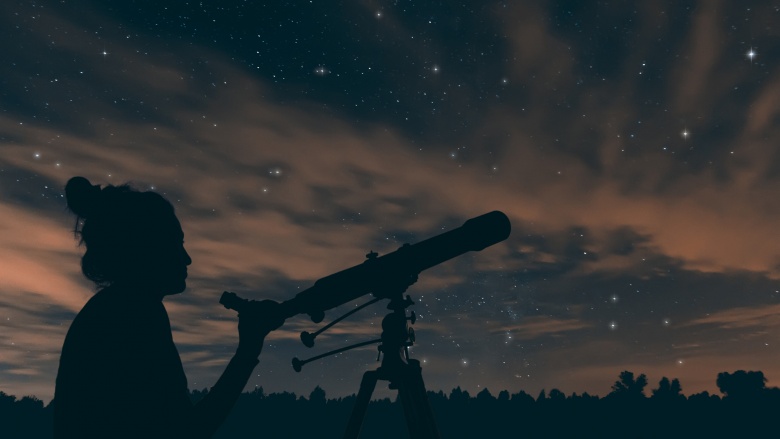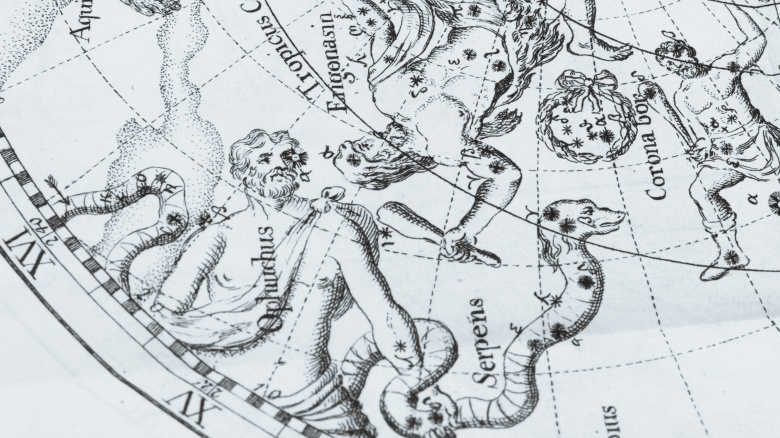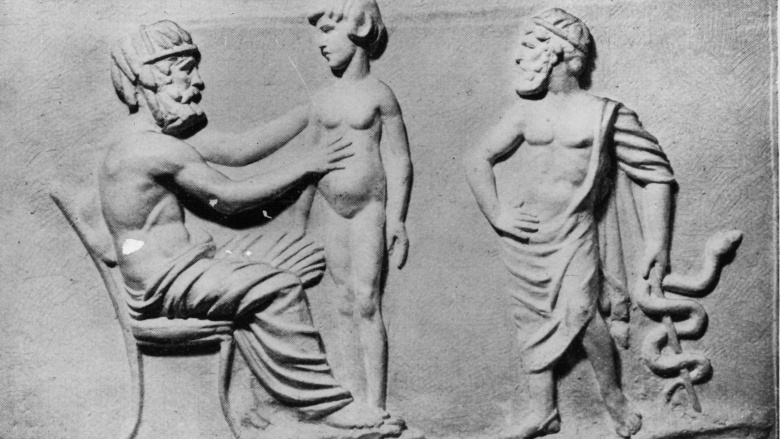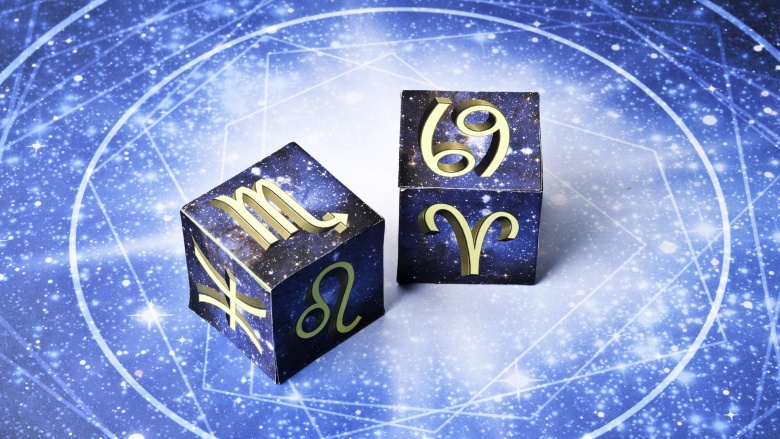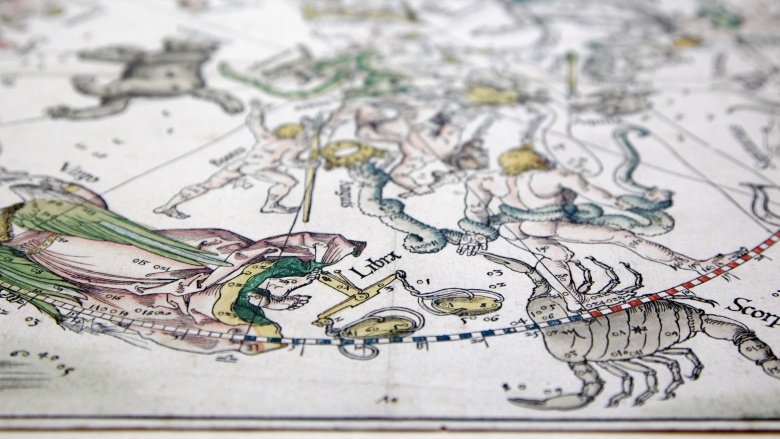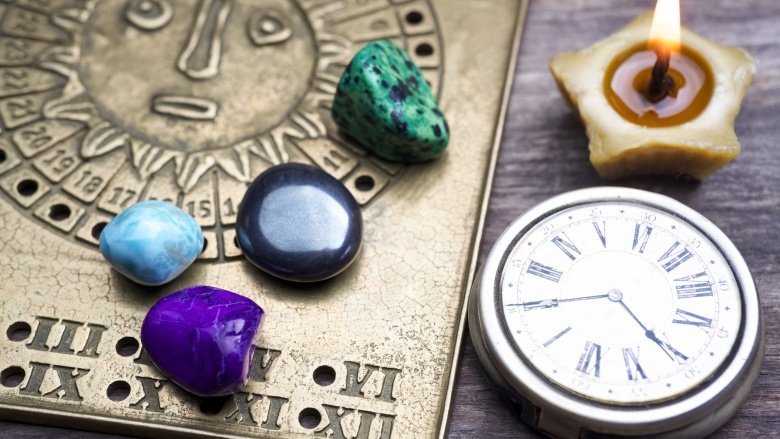What The Thirteenth Zodiac Sign Means For You
Every so often, the internet is sent into a collective tailspin with the news that there's something new in the zodiac. A source of much of the fuss is a constellation is called Ophiuchus, and it's usually suggested that his appearance means we're going to have to do everything from reassign new dates to the star signs to figure out a way to cover any newly incorrect zodiac sign tattoos. The whole thing can be a bit confusing, so we wanted to get to the bottom of what the thirteenth zodiac sign means for you.
How does the zodiac work, anyway?
To start, let's take a look at exactly what the zodiac is. As we move around the sun, we follow the same path over and over again. From our point of view, that means the sun rises and sets through a series of different constellations, depending on where we are in our orbit (and what month it is). Say, for example, it's September. The sun sits between Earth and the stars that make up the constellation Virgo, so from our point of view, as our planet rotates, the sun moves across the sky in front of Virgo. Opposite us is Pisces, and that means the same thing appears to happen through Pisces six months later. NASA describes another way of looking at it. If, at any given time, you were to draw a straight line from Earth right through the sun, the constellation the line hits next is that moment's zodiac. That's the astrological belief, but astronomy is at odds with it... and we'll look at why in a minute.
Confusing, right? It's all pretty abstract, and it's basically an optical illusion based on the movement of our own planet, the sun, and the position of the stars in the sky. That's actually an incredibly simplified version of what's going on, and if you really, really want to get a good understanding of how it all works, we suggest taking a few pieces of fruit and laying out a map on your kitchen table. A visual aid is hugely helpful in something like this, as it's tough to imagine the sheer scale of what's going on around us.
Over the centuries, the constellations of the zodiac haven't just been tied to astrology, but to navigation and cartography, too. Since our planet revolves around the sun on the same plane over and over again relative to the rest of the universe, that means the constellations along that orbit (the ecliptic) remain fairly stable, and that's defined the center of the zodiac.
So, who invented these signs?
Astrology and astronomy are polar opposites, but one thing NASA and the American Federation of Astrologers do agree on is that the idea of the zodiac dates back to ancient Babylon, around 3,000 years ago. When Babylonian astronomers looked at the night sky, they started to map out patterns in the stars. They were the ones that chose particular stars to arrange into the symbols we still see today. The Babylonians were already working off a 12-month calendar (that they based on the moon), so when they mapped and divided the sky they used 12 areas. By the 4th century BC, those same signs had been adopted by the Greeks, the Romans and the Arab world, and that means the idea of a 13th sign seems to go against a huge amount of history.
Weirdly, though, NASA says that the Babylonians had included our rogue 13th sign in their legends and lore. Ophiuchus was a part of Babylonian lore, but the idea of 13 signs didn't sync with their 12-month calendar. They left him out, and it was the simplified version of the whole idea that spread.
Who (and what) is Ophiuchus?
If you're familiar with some of the signs of the long-accepted zodiac, you can find Ophiuchus above and between the constellations Scorpio and Sagittarius. He's called The Serpent Bearer, and he's pretty unique in that he's actually holding another constellation: Serpens the Serpent. The sun moves through him from November 29 to December 18, overlapping with the accepted zodiac sign of Sagittarius (which runs from November 21 to December 21).
While Ophiuchus has only only been mentioned in conjunction with the zodiac fairly recently, you're more than familiar with his story and the symbols we get from him. According to the ancient Greeks, Ophiuchus is the constellation that represents Asclepius. The world's first doctor, he got the attention of the gods when he created a potion that could resurrect the dead. He used the venom of a snake and the blood of a Gorgon to create the potion and when he did, he was clearly upsetting the natural order of life itself. Zeus took the potion away and raised Asclepius into the heavens, where he spends eternity with the snake that was both his glory and his downfall.
If you've ever seen the symbol of the staff with the snake around it, that's the Rod of Asclepius. It's one of two medical symbols that involve snakes and a staff, and it's a nod to that first Greek doctor. The other symbol is the caduceus, and that's the one that has wings. It's a completely different story, and that particular staff belonged to Hermes.
Ophiuchus has popped up before
Ophiuchus has been around for a long time, and he's definitely not a newcomer to astronomical star charts. Astrology is a different matter, though, and when Nature World News took a look at just when the panic over Ophiuchus first started, and they traced the uproar about the idea of a new interloper into the long-accepted zodiac to as early as 2000. The story pops up every so often, and astronomer Phil Plait took a look at just what's going on — and why he continues to cause problems.
Plait found that the story was repeated in 2011, and again in 2016, each time creating something of a furor over the idea that NASA was changing the zodiac. Part of the problem, he says, is the confusion between astrology and astronomy. NASA has nothing to do with the astrological zodiac, as they have nothing to do with astrology. The announcement NASA made had to do with the way Earth's rotation has changed over the centuries, and how we're pointed in a slightly different direction than we used to be (and more on that in a minute). Ophiuchus has always been there, and there's nothing that's actually, really changing. Most of what you might have heard about NASA changing the signs of the zodiac is nothing more than a few misleading headlines and an age-old confusion.
The zodiac is always changing, and here's why
When Ophiuchus showed up in 2011 and started causing all sorts of trouble, it was traced back to an article in the Minneapolis Star-Tribune. Astronomer Park Kunkle was talking about what's called precession and its relationship to what's going on with our planet. Kunkle used the example of spinning a top. At first, the top has an incredibly tight spin, but as it starts to lose momentum it begins to wobble. That wobbling is exactly what our planet does, on an obviously much, much larger scale. There's a couple of different things this means, and one of those things is that Polaris hasn't always been (and soon won't be) our North Star. That also means the constellations the sun appears to move through are different than the ones first recorded by the Babylonians 3,000 years ago. Since the "sun sign" is what the astrological zodiac is based on, it's never been actually, astronomically correct.
This wobble isn't something we've only recently found out about, either, even though it takes about 26,000 years for the planet to do a complete wobble. The first person to figure out the planet wasn't revolving in an exact, perfect way was Hipparchus of Nicea, and he was studying the world around him in 130 BC. Kunkle's comments regarding the wobble simply pointed out that the sun traveled through Ophiuchus, too, and the whole thing spiraled out across the information superhighway from there.
Sidereal vs. Tropical zodiacs
Right, so what's this all mean for your horoscope and that zodiac sign tattoo you have?
Chances are, you've come up with your zodiac sign based on what's called the Tropical zodiac. It has a pretty ancient history, too, developed in ancient Greece by Ptolemy. In the second century, astrology and astronomy were one and the same, and it was Ptolemy who created a static, unchanging version of the zodiac that remains the same no matter how the actual, physical constellations shift. His zodiac started with something that should sound familiar: Aries, and the sun's position on March 21. That's a significant date, and it's the spring equinox.
That's only one form of the zodiac. In Vedic astrology, the sidereal zodiac reflects what's actually going on in the stars at any particular time. As its name suggests, this particular type of astrology is rooted in India and Hindu beliefs, part of the six limbs of the Vedas and an integral part of an entire belief system. This is the form of the zodiac that changes, and there's such a difference between this zodiac and the Tropical one that most people find they have two completely different signs when they compare the two different zodiacs.
… and that's why your sign definitely didn't change
Most of the Western world follows Ptolemy's Tropical zodiac, and that's the one that doesn't change no matter what's going on in the stars. Those in the Eastern world who follow the Vedic or Sidereal zodiac are the ones with the changing zodiac, and the nature of that particular zodiac already accounts for that. Since the Western zodiac is aligned more with the seasons than with the constellations, that hasn't changed in the least.
So, that probably brings up another question. If astrology and our star sign is supposed to influence our lives but we follow a zodiac that has nothing to do with the constellations, what's the reasoning behind it?
Astrologer Jeff Jawer says that the argument for a Tropical and unchanging zodiac is a pretty straightforward one. He says that astrology is a geocentric phenomenon, one that's related more to what's going on in our own very earthly lives than to anything that's happening up in the stars. That means it's the Tropical zodiac that's been used for hundreds and hundreds of years, and it's the one that's not going to change in the least. That ultimately means you can rest easy knowing your star sign isn't going to change, either.
Technically, there should be 21 different signs
Ophiuchus gets a bad reputation as an interloper into the zodiac, but if he's always been there, it's a reasonable question to ask just what other constellations didn't get a mention, and just why Ophiuchus didn't get a place in the zodiac in the first place. According to Phil Plait, the 12 constellations of the zodiac were chosen because they were the brightest and the easiest to find. Even though the sun only spends a few days in Scorpius, it's a brighter constellation that has a shape that stands out in the night sky much more than the bigger, but fainter Ophiuchus. That gave Scorpio a larger slice of the night sky pie.
Meanwhile, John Mosley of the Griffith Observatory took a look at just how many constellations really are within the path of the zodiac. He found there are actually 21 constellations that are a part of the zodiac, and that Ophiuchus is just one of the constellations that doesn't get mentioned on the official list of the astrological zodiac. Depending on when you were born, the sun might have actually been moving through constellations like Corvus (the Crow), Pegasus (the winged horse), and Hydra (the cosmic snake).
How many people believe astrology is a science?
We've answered (albeit in a roundabout sort of way) the question of just what the 13th zodiac sign means for you (absolutely nothing). But that brings up another question, and that's the question of just why there's all the fuss in the first place, and why astrology and astronomy still get confused.
In 2014, the National Science Foundation found about 40 percent of of Americans thought astrology was a tried-and-true science. In a 2005 study done by Gallup, it was found that more women than men believe in astrology, and York University sociologist Julia Hemphill says that's likely because it's something that's marketed toward women more so than men. Compare women's magazines and television networks to those marketing toward men, and you already know which one is going to have more information about astrology and other supernatural concepts.
And that's likely because astrology supports ideas like destiny and fate, purporting to give a glimpse into a future that's already written in the stars. Unfortunately, a strict belief in astrology can make us overlook future potential, and lock us into making decisions that we might otherwise never make. While most people seem to read their astrological signs simply for fun, there's plenty of people — including Carl Sagan — who say it's simply a way of giving a sort of cosmic significance to our earthly lives, and that we shouldn't rely on it to guide our choices or our lives.


